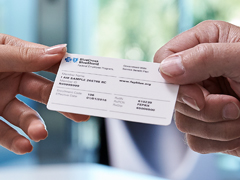The 4-Step Financial Diet

We all know that money doesn’t equal happiness, but it sure can have an impact on our overall health. Just remember that like physical health, being financially fit takes time.
Step 1: Log your spending.
Before you do anything else, it’s important to know your current state of affairs. To really understand where your money goes, keep a daily log of income and expenses for an entire month. To go a step further, see how your expense log compares to other monthly bank statements.
Step 2: Budget for the big picture.
Keep this simple. There are plenty of apps and services to help you create a realistic budget based on your daily spending habits. But be sure to consider non-monthly expenses that pop up throughout the year, including estimated healthcare costs.
Step 3: Trim the fat.
Look through your expense log and highlight every transaction that wasn’t absolutely necessary. Now imagine if each of these expenses were an unhealthy snack. Are there areas where you could make healthier choices? Are there areas where you can afford to indulge less?
Step 4: Review and revise.
Staying on top of your financial health is a moving target. Start making small changes and make adjustments as you go. Use your Financial Dashboard to access your healthcare spending in real time. It’ll help you see changes in your healthcare finances and show you where you can save money.


